OGBH201: Managing Conflict & Diversity in Organisational Behaviour
VerifiedAdded on 2024/05/30
|10
|2909
|436
Annotated Bibliography
AI Summary
This annotated bibliography focuses on conflict within organisations, highlighting its causes, management, and potential resolutions. It addresses diverse types of conflicts arising from differing ideas, goals, and values among employees. The document emphasizes the importance of conflict management skills in today's market conditions, exploring various approaches and tactics to handle disputes effectively. It covers relational conflicts, personality conflicts stemming from poor communication, and intercultural variances. The bibliography also examines strategies such as collaboration, compromise, and competition, along with structured steps for conflict resolution, including understanding the situation, acknowledging the problem, and maintaining open communication. Furthermore, it discusses the role of conflict mediation and the potential adverse effects of unresolved conflicts, such as employee turnover and mental health concerns. Desklib provides access to this and other solved assignments.
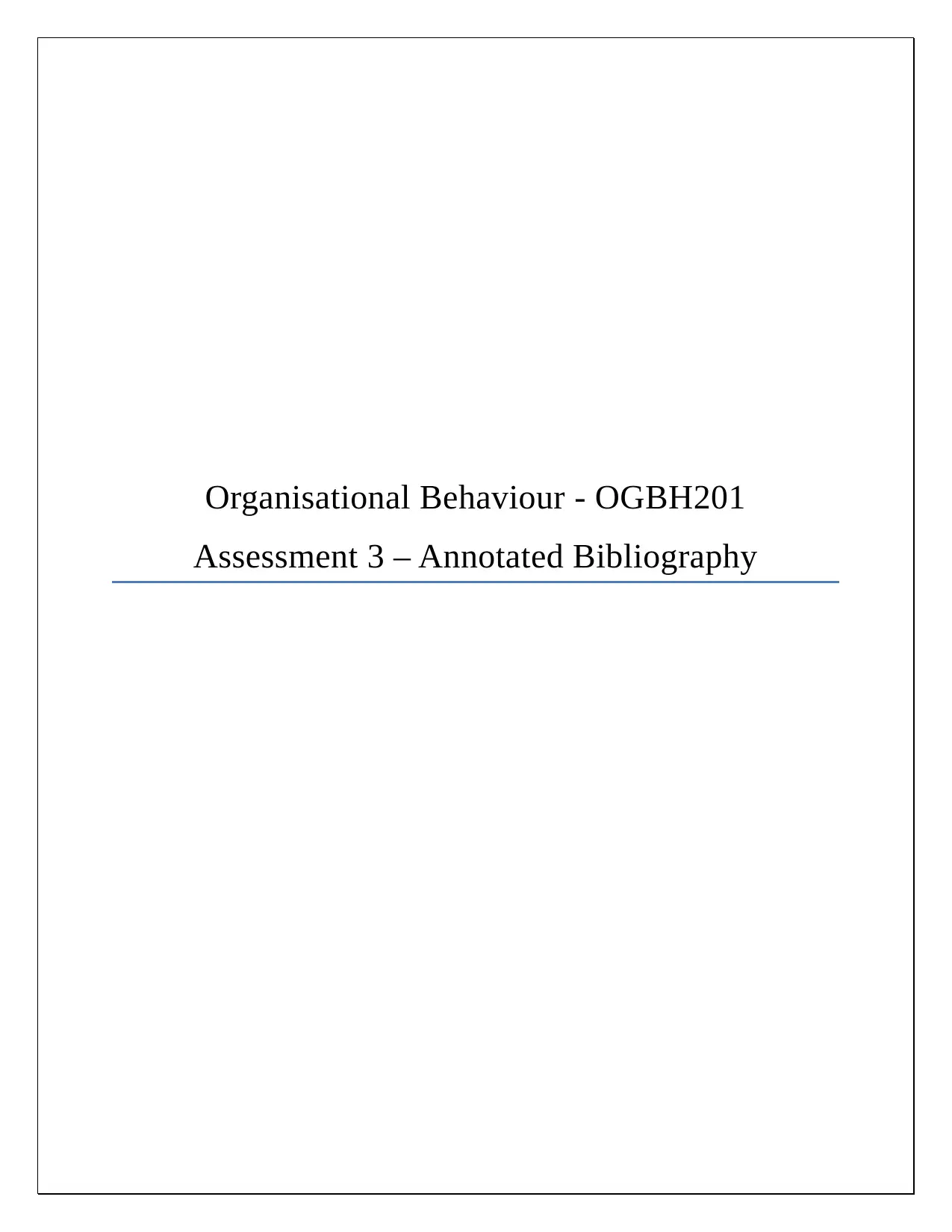
Organisational Behaviour - OGBH201
Assessment 3 – Annotated Bibliography
Assessment 3 – Annotated Bibliography
Paraphrase This Document
Need a fresh take? Get an instant paraphrase of this document with our AI Paraphraser
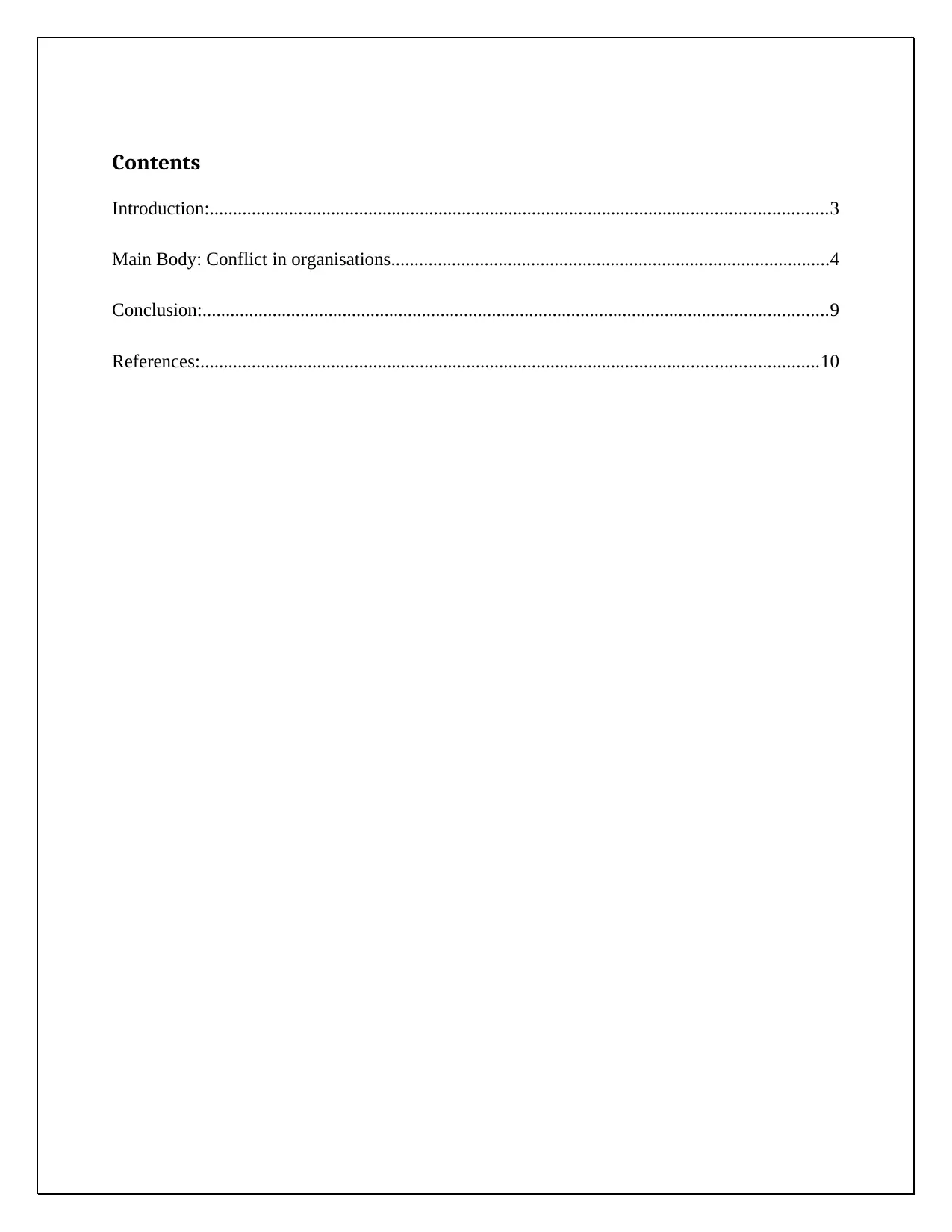
Contents
Introduction:....................................................................................................................................3
Main Body: Conflict in organisations..............................................................................................4
Conclusion:......................................................................................................................................9
References:....................................................................................................................................10
Introduction:....................................................................................................................................3
Main Body: Conflict in organisations..............................................................................................4
Conclusion:......................................................................................................................................9
References:....................................................................................................................................10
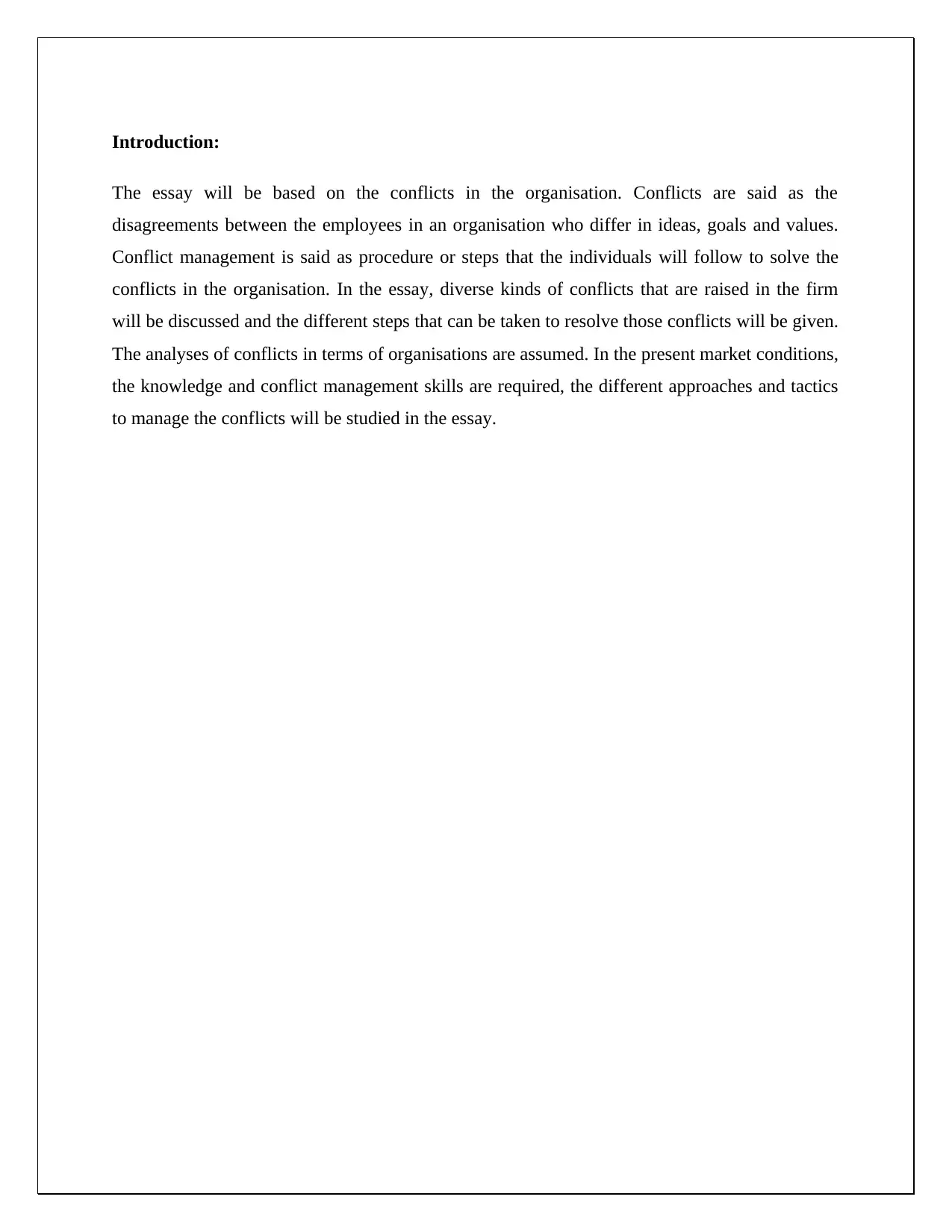
Introduction:
The essay will be based on the conflicts in the organisation. Conflicts are said as the
disagreements between the employees in an organisation who differ in ideas, goals and values.
Conflict management is said as procedure or steps that the individuals will follow to solve the
conflicts in the organisation. In the essay, diverse kinds of conflicts that are raised in the firm
will be discussed and the different steps that can be taken to resolve those conflicts will be given.
The analyses of conflicts in terms of organisations are assumed. In the present market conditions,
the knowledge and conflict management skills are required, the different approaches and tactics
to manage the conflicts will be studied in the essay.
The essay will be based on the conflicts in the organisation. Conflicts are said as the
disagreements between the employees in an organisation who differ in ideas, goals and values.
Conflict management is said as procedure or steps that the individuals will follow to solve the
conflicts in the organisation. In the essay, diverse kinds of conflicts that are raised in the firm
will be discussed and the different steps that can be taken to resolve those conflicts will be given.
The analyses of conflicts in terms of organisations are assumed. In the present market conditions,
the knowledge and conflict management skills are required, the different approaches and tactics
to manage the conflicts will be studied in the essay.
⊘ This is a preview!⊘
Do you want full access?
Subscribe today to unlock all pages.

Trusted by 1+ million students worldwide
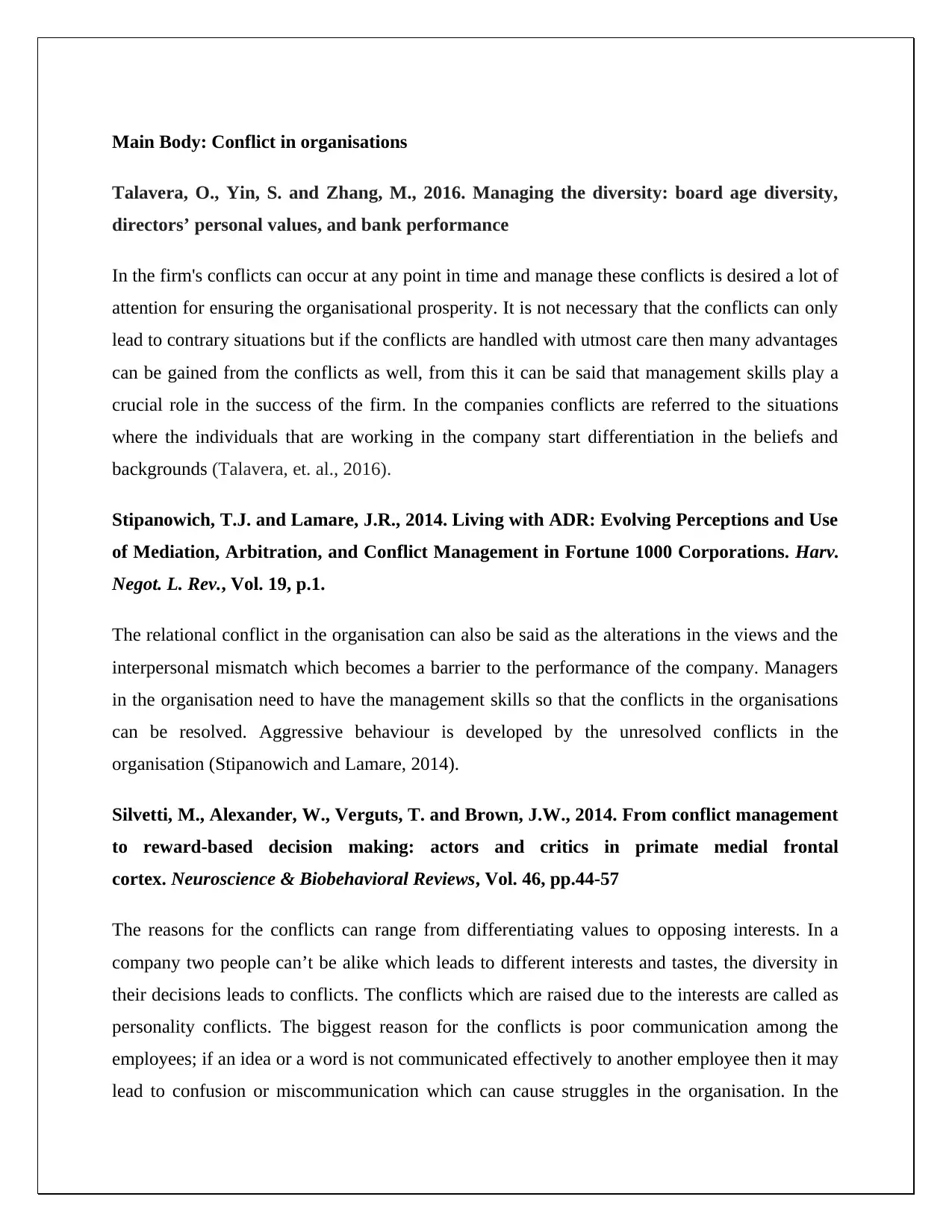
Main Body: Conflict in organisations
Talavera, O., Yin, S. and Zhang, M., 2016. Managing the diversity: board age diversity,
directors’ personal values, and bank performance
In the firm's conflicts can occur at any point in time and manage these conflicts is desired a lot of
attention for ensuring the organisational prosperity. It is not necessary that the conflicts can only
lead to contrary situations but if the conflicts are handled with utmost care then many advantages
can be gained from the conflicts as well, from this it can be said that management skills play a
crucial role in the success of the firm. In the companies conflicts are referred to the situations
where the individuals that are working in the company start differentiation in the beliefs and
backgrounds (Talavera, et. al., 2016).
Stipanowich, T.J. and Lamare, J.R., 2014. Living with ADR: Evolving Perceptions and Use
of Mediation, Arbitration, and Conflict Management in Fortune 1000 Corporations. Harv.
Negot. L. Rev., Vol. 19, p.1.
The relational conflict in the organisation can also be said as the alterations in the views and the
interpersonal mismatch which becomes a barrier to the performance of the company. Managers
in the organisation need to have the management skills so that the conflicts in the organisations
can be resolved. Aggressive behaviour is developed by the unresolved conflicts in the
organisation (Stipanowich and Lamare, 2014).
Silvetti, M., Alexander, W., Verguts, T. and Brown, J.W., 2014. From conflict management
to reward-based decision making: actors and critics in primate medial frontal
cortex. Neuroscience & Biobehavioral Reviews, Vol. 46, pp.44-57
The reasons for the conflicts can range from differentiating values to opposing interests. In a
company two people can’t be alike which leads to different interests and tastes, the diversity in
their decisions leads to conflicts. The conflicts which are raised due to the interests are called as
personality conflicts. The biggest reason for the conflicts is poor communication among the
employees; if an idea or a word is not communicated effectively to another employee then it may
lead to confusion or miscommunication which can cause struggles in the organisation. In the
Talavera, O., Yin, S. and Zhang, M., 2016. Managing the diversity: board age diversity,
directors’ personal values, and bank performance
In the firm's conflicts can occur at any point in time and manage these conflicts is desired a lot of
attention for ensuring the organisational prosperity. It is not necessary that the conflicts can only
lead to contrary situations but if the conflicts are handled with utmost care then many advantages
can be gained from the conflicts as well, from this it can be said that management skills play a
crucial role in the success of the firm. In the companies conflicts are referred to the situations
where the individuals that are working in the company start differentiation in the beliefs and
backgrounds (Talavera, et. al., 2016).
Stipanowich, T.J. and Lamare, J.R., 2014. Living with ADR: Evolving Perceptions and Use
of Mediation, Arbitration, and Conflict Management in Fortune 1000 Corporations. Harv.
Negot. L. Rev., Vol. 19, p.1.
The relational conflict in the organisation can also be said as the alterations in the views and the
interpersonal mismatch which becomes a barrier to the performance of the company. Managers
in the organisation need to have the management skills so that the conflicts in the organisations
can be resolved. Aggressive behaviour is developed by the unresolved conflicts in the
organisation (Stipanowich and Lamare, 2014).
Silvetti, M., Alexander, W., Verguts, T. and Brown, J.W., 2014. From conflict management
to reward-based decision making: actors and critics in primate medial frontal
cortex. Neuroscience & Biobehavioral Reviews, Vol. 46, pp.44-57
The reasons for the conflicts can range from differentiating values to opposing interests. In a
company two people can’t be alike which leads to different interests and tastes, the diversity in
their decisions leads to conflicts. The conflicts which are raised due to the interests are called as
personality conflicts. The biggest reason for the conflicts is poor communication among the
employees; if an idea or a word is not communicated effectively to another employee then it may
lead to confusion or miscommunication which can cause struggles in the organisation. In the
Paraphrase This Document
Need a fresh take? Get an instant paraphrase of this document with our AI Paraphraser
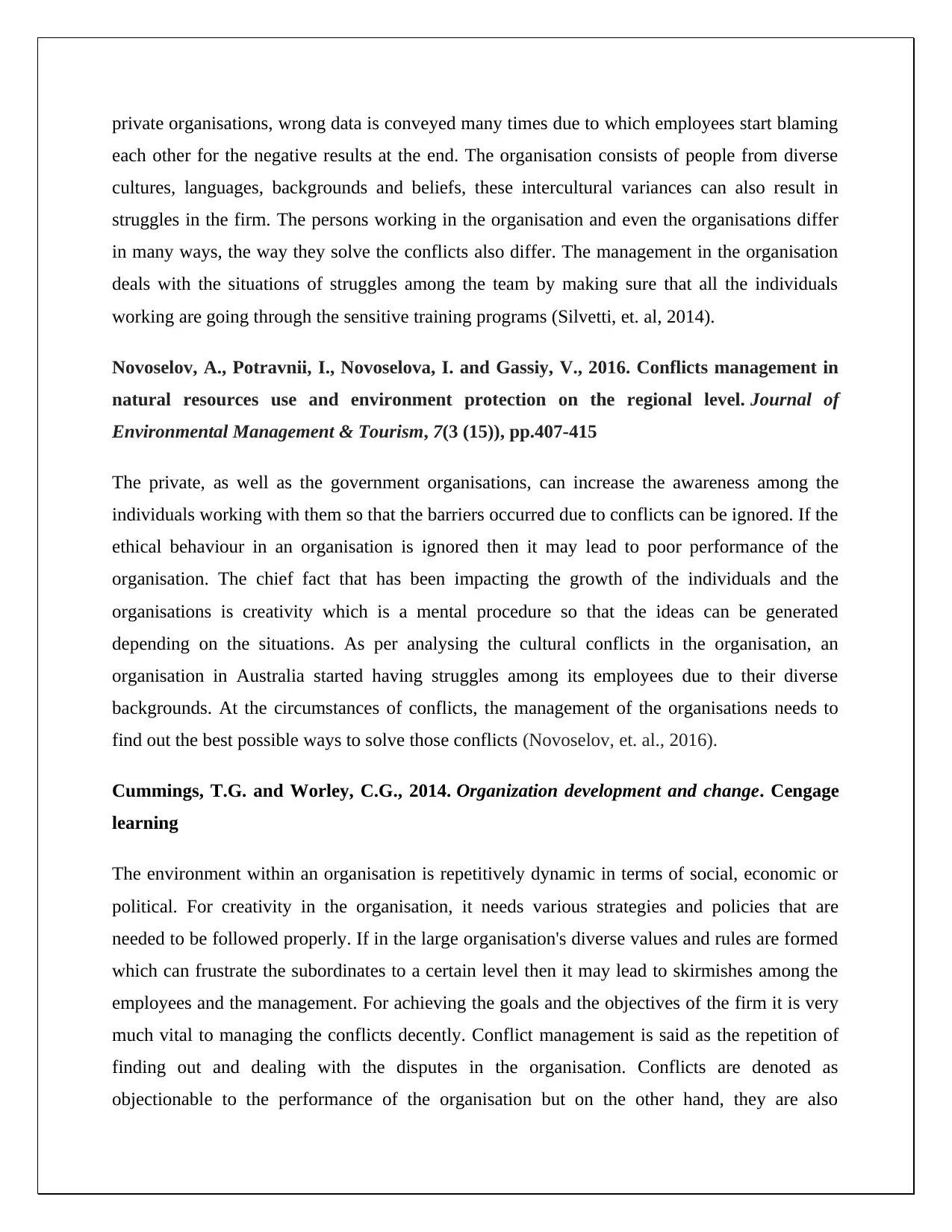
private organisations, wrong data is conveyed many times due to which employees start blaming
each other for the negative results at the end. The organisation consists of people from diverse
cultures, languages, backgrounds and beliefs, these intercultural variances can also result in
struggles in the firm. The persons working in the organisation and even the organisations differ
in many ways, the way they solve the conflicts also differ. The management in the organisation
deals with the situations of struggles among the team by making sure that all the individuals
working are going through the sensitive training programs (Silvetti, et. al, 2014).
Novoselov, A., Potravnii, I., Novoselova, I. and Gassiy, V., 2016. Conflicts management in
natural resources use and environment protection on the regional level. Journal of
Environmental Management & Tourism, 7(3 (15)), pp.407-415
The private, as well as the government organisations, can increase the awareness among the
individuals working with them so that the barriers occurred due to conflicts can be ignored. If the
ethical behaviour in an organisation is ignored then it may lead to poor performance of the
organisation. The chief fact that has been impacting the growth of the individuals and the
organisations is creativity which is a mental procedure so that the ideas can be generated
depending on the situations. As per analysing the cultural conflicts in the organisation, an
organisation in Australia started having struggles among its employees due to their diverse
backgrounds. At the circumstances of conflicts, the management of the organisations needs to
find out the best possible ways to solve those conflicts (Novoselov, et. al., 2016).
Cummings, T.G. and Worley, C.G., 2014. Organization development and change. Cengage
learning
The environment within an organisation is repetitively dynamic in terms of social, economic or
political. For creativity in the organisation, it needs various strategies and policies that are
needed to be followed properly. If in the large organisation's diverse values and rules are formed
which can frustrate the subordinates to a certain level then it may lead to skirmishes among the
employees and the management. For achieving the goals and the objectives of the firm it is very
much vital to managing the conflicts decently. Conflict management is said as the repetition of
finding out and dealing with the disputes in the organisation. Conflicts are denoted as
objectionable to the performance of the organisation but on the other hand, they are also
each other for the negative results at the end. The organisation consists of people from diverse
cultures, languages, backgrounds and beliefs, these intercultural variances can also result in
struggles in the firm. The persons working in the organisation and even the organisations differ
in many ways, the way they solve the conflicts also differ. The management in the organisation
deals with the situations of struggles among the team by making sure that all the individuals
working are going through the sensitive training programs (Silvetti, et. al, 2014).
Novoselov, A., Potravnii, I., Novoselova, I. and Gassiy, V., 2016. Conflicts management in
natural resources use and environment protection on the regional level. Journal of
Environmental Management & Tourism, 7(3 (15)), pp.407-415
The private, as well as the government organisations, can increase the awareness among the
individuals working with them so that the barriers occurred due to conflicts can be ignored. If the
ethical behaviour in an organisation is ignored then it may lead to poor performance of the
organisation. The chief fact that has been impacting the growth of the individuals and the
organisations is creativity which is a mental procedure so that the ideas can be generated
depending on the situations. As per analysing the cultural conflicts in the organisation, an
organisation in Australia started having struggles among its employees due to their diverse
backgrounds. At the circumstances of conflicts, the management of the organisations needs to
find out the best possible ways to solve those conflicts (Novoselov, et. al., 2016).
Cummings, T.G. and Worley, C.G., 2014. Organization development and change. Cengage
learning
The environment within an organisation is repetitively dynamic in terms of social, economic or
political. For creativity in the organisation, it needs various strategies and policies that are
needed to be followed properly. If in the large organisation's diverse values and rules are formed
which can frustrate the subordinates to a certain level then it may lead to skirmishes among the
employees and the management. For achieving the goals and the objectives of the firm it is very
much vital to managing the conflicts decently. Conflict management is said as the repetition of
finding out and dealing with the disputes in the organisation. Conflicts are denoted as
objectionable to the performance of the organisation but on the other hand, they are also
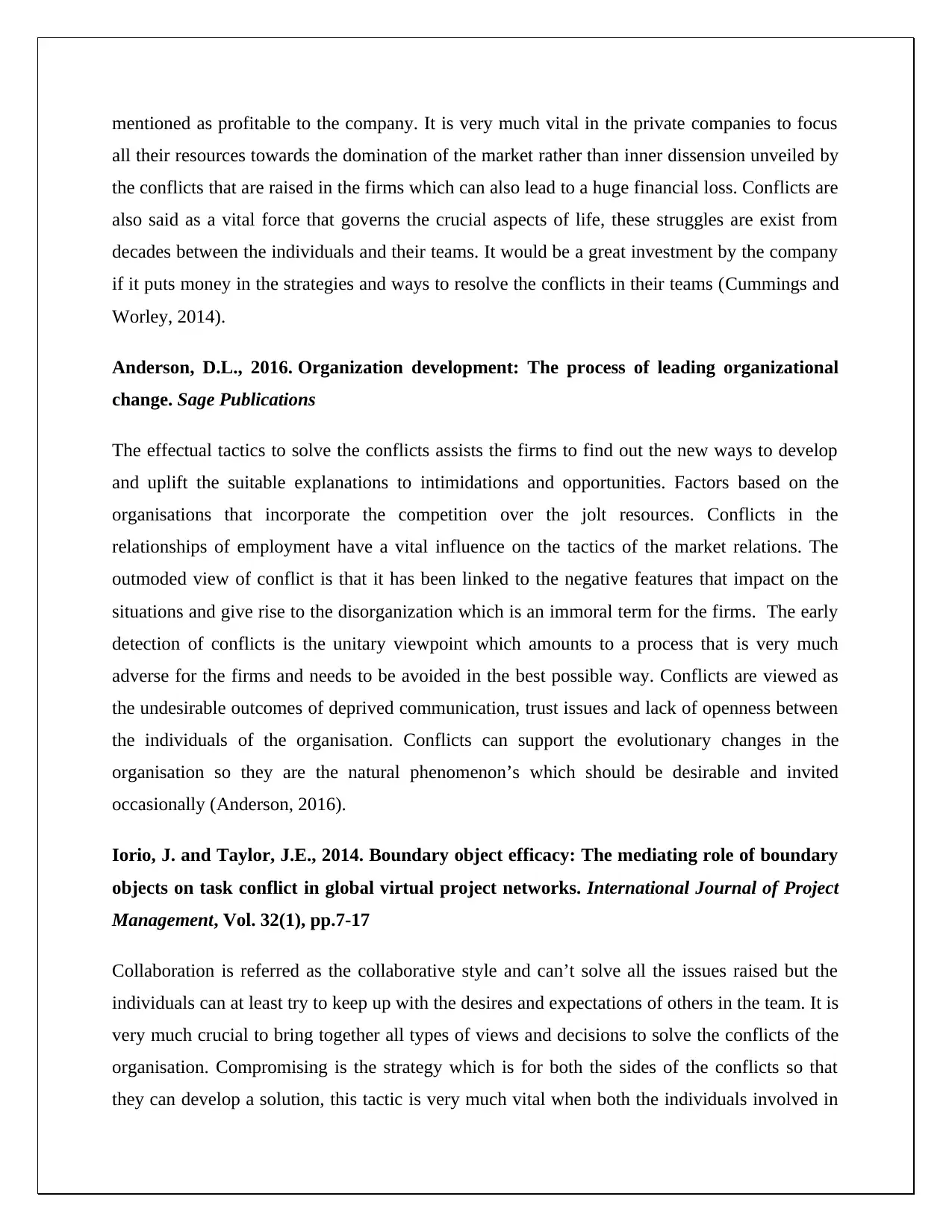
mentioned as profitable to the company. It is very much vital in the private companies to focus
all their resources towards the domination of the market rather than inner dissension unveiled by
the conflicts that are raised in the firms which can also lead to a huge financial loss. Conflicts are
also said as a vital force that governs the crucial aspects of life, these struggles are exist from
decades between the individuals and their teams. It would be a great investment by the company
if it puts money in the strategies and ways to resolve the conflicts in their teams (Cummings and
Worley, 2014).
Anderson, D.L., 2016. Organization development: The process of leading organizational
change. Sage Publications
The effectual tactics to solve the conflicts assists the firms to find out the new ways to develop
and uplift the suitable explanations to intimidations and opportunities. Factors based on the
organisations that incorporate the competition over the jolt resources. Conflicts in the
relationships of employment have a vital influence on the tactics of the market relations. The
outmoded view of conflict is that it has been linked to the negative features that impact on the
situations and give rise to the disorganization which is an immoral term for the firms. The early
detection of conflicts is the unitary viewpoint which amounts to a process that is very much
adverse for the firms and needs to be avoided in the best possible way. Conflicts are viewed as
the undesirable outcomes of deprived communication, trust issues and lack of openness between
the individuals of the organisation. Conflicts can support the evolutionary changes in the
organisation so they are the natural phenomenon’s which should be desirable and invited
occasionally (Anderson, 2016).
Iorio, J. and Taylor, J.E., 2014. Boundary object efficacy: The mediating role of boundary
objects on task conflict in global virtual project networks. International Journal of Project
Management, Vol. 32(1), pp.7-17
Collaboration is referred as the collaborative style and can’t solve all the issues raised but the
individuals can at least try to keep up with the desires and expectations of others in the team. It is
very much crucial to bring together all types of views and decisions to solve the conflicts of the
organisation. Compromising is the strategy which is for both the sides of the conflicts so that
they can develop a solution, this tactic is very much vital when both the individuals involved in
all their resources towards the domination of the market rather than inner dissension unveiled by
the conflicts that are raised in the firms which can also lead to a huge financial loss. Conflicts are
also said as a vital force that governs the crucial aspects of life, these struggles are exist from
decades between the individuals and their teams. It would be a great investment by the company
if it puts money in the strategies and ways to resolve the conflicts in their teams (Cummings and
Worley, 2014).
Anderson, D.L., 2016. Organization development: The process of leading organizational
change. Sage Publications
The effectual tactics to solve the conflicts assists the firms to find out the new ways to develop
and uplift the suitable explanations to intimidations and opportunities. Factors based on the
organisations that incorporate the competition over the jolt resources. Conflicts in the
relationships of employment have a vital influence on the tactics of the market relations. The
outmoded view of conflict is that it has been linked to the negative features that impact on the
situations and give rise to the disorganization which is an immoral term for the firms. The early
detection of conflicts is the unitary viewpoint which amounts to a process that is very much
adverse for the firms and needs to be avoided in the best possible way. Conflicts are viewed as
the undesirable outcomes of deprived communication, trust issues and lack of openness between
the individuals of the organisation. Conflicts can support the evolutionary changes in the
organisation so they are the natural phenomenon’s which should be desirable and invited
occasionally (Anderson, 2016).
Iorio, J. and Taylor, J.E., 2014. Boundary object efficacy: The mediating role of boundary
objects on task conflict in global virtual project networks. International Journal of Project
Management, Vol. 32(1), pp.7-17
Collaboration is referred as the collaborative style and can’t solve all the issues raised but the
individuals can at least try to keep up with the desires and expectations of others in the team. It is
very much crucial to bring together all types of views and decisions to solve the conflicts of the
organisation. Compromising is the strategy which is for both the sides of the conflicts so that
they can develop a solution, this tactic is very much vital when both the individuals involved in
⊘ This is a preview!⊘
Do you want full access?
Subscribe today to unlock all pages.

Trusted by 1+ million students worldwide
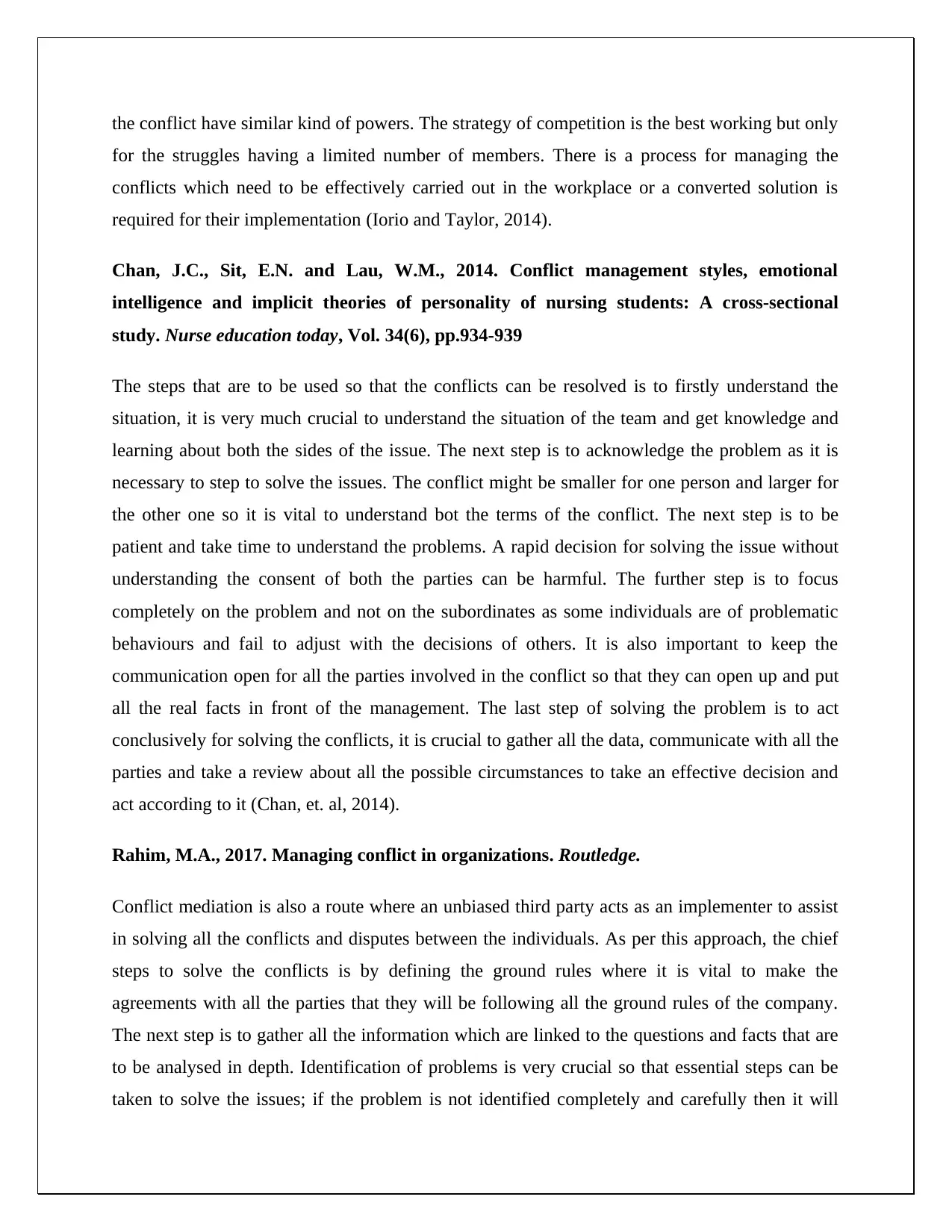
the conflict have similar kind of powers. The strategy of competition is the best working but only
for the struggles having a limited number of members. There is a process for managing the
conflicts which need to be effectively carried out in the workplace or a converted solution is
required for their implementation (Iorio and Taylor, 2014).
Chan, J.C., Sit, E.N. and Lau, W.M., 2014. Conflict management styles, emotional
intelligence and implicit theories of personality of nursing students: A cross-sectional
study. Nurse education today, Vol. 34(6), pp.934-939
The steps that are to be used so that the conflicts can be resolved is to firstly understand the
situation, it is very much crucial to understand the situation of the team and get knowledge and
learning about both the sides of the issue. The next step is to acknowledge the problem as it is
necessary to step to solve the issues. The conflict might be smaller for one person and larger for
the other one so it is vital to understand bot the terms of the conflict. The next step is to be
patient and take time to understand the problems. A rapid decision for solving the issue without
understanding the consent of both the parties can be harmful. The further step is to focus
completely on the problem and not on the subordinates as some individuals are of problematic
behaviours and fail to adjust with the decisions of others. It is also important to keep the
communication open for all the parties involved in the conflict so that they can open up and put
all the real facts in front of the management. The last step of solving the problem is to act
conclusively for solving the conflicts, it is crucial to gather all the data, communicate with all the
parties and take a review about all the possible circumstances to take an effective decision and
act according to it (Chan, et. al, 2014).
Rahim, M.A., 2017. Managing conflict in organizations. Routledge.
Conflict mediation is also a route where an unbiased third party acts as an implementer to assist
in solving all the conflicts and disputes between the individuals. As per this approach, the chief
steps to solve the conflicts is by defining the ground rules where it is vital to make the
agreements with all the parties that they will be following all the ground rules of the company.
The next step is to gather all the information which are linked to the questions and facts that are
to be analysed in depth. Identification of problems is very crucial so that essential steps can be
taken to solve the issues; if the problem is not identified completely and carefully then it will
for the struggles having a limited number of members. There is a process for managing the
conflicts which need to be effectively carried out in the workplace or a converted solution is
required for their implementation (Iorio and Taylor, 2014).
Chan, J.C., Sit, E.N. and Lau, W.M., 2014. Conflict management styles, emotional
intelligence and implicit theories of personality of nursing students: A cross-sectional
study. Nurse education today, Vol. 34(6), pp.934-939
The steps that are to be used so that the conflicts can be resolved is to firstly understand the
situation, it is very much crucial to understand the situation of the team and get knowledge and
learning about both the sides of the issue. The next step is to acknowledge the problem as it is
necessary to step to solve the issues. The conflict might be smaller for one person and larger for
the other one so it is vital to understand bot the terms of the conflict. The next step is to be
patient and take time to understand the problems. A rapid decision for solving the issue without
understanding the consent of both the parties can be harmful. The further step is to focus
completely on the problem and not on the subordinates as some individuals are of problematic
behaviours and fail to adjust with the decisions of others. It is also important to keep the
communication open for all the parties involved in the conflict so that they can open up and put
all the real facts in front of the management. The last step of solving the problem is to act
conclusively for solving the conflicts, it is crucial to gather all the data, communicate with all the
parties and take a review about all the possible circumstances to take an effective decision and
act according to it (Chan, et. al, 2014).
Rahim, M.A., 2017. Managing conflict in organizations. Routledge.
Conflict mediation is also a route where an unbiased third party acts as an implementer to assist
in solving all the conflicts and disputes between the individuals. As per this approach, the chief
steps to solve the conflicts is by defining the ground rules where it is vital to make the
agreements with all the parties that they will be following all the ground rules of the company.
The next step is to gather all the information which are linked to the questions and facts that are
to be analysed in depth. Identification of problems is very crucial so that essential steps can be
taken to solve the issues; if the problem is not identified completely and carefully then it will
Paraphrase This Document
Need a fresh take? Get an instant paraphrase of this document with our AI Paraphraser
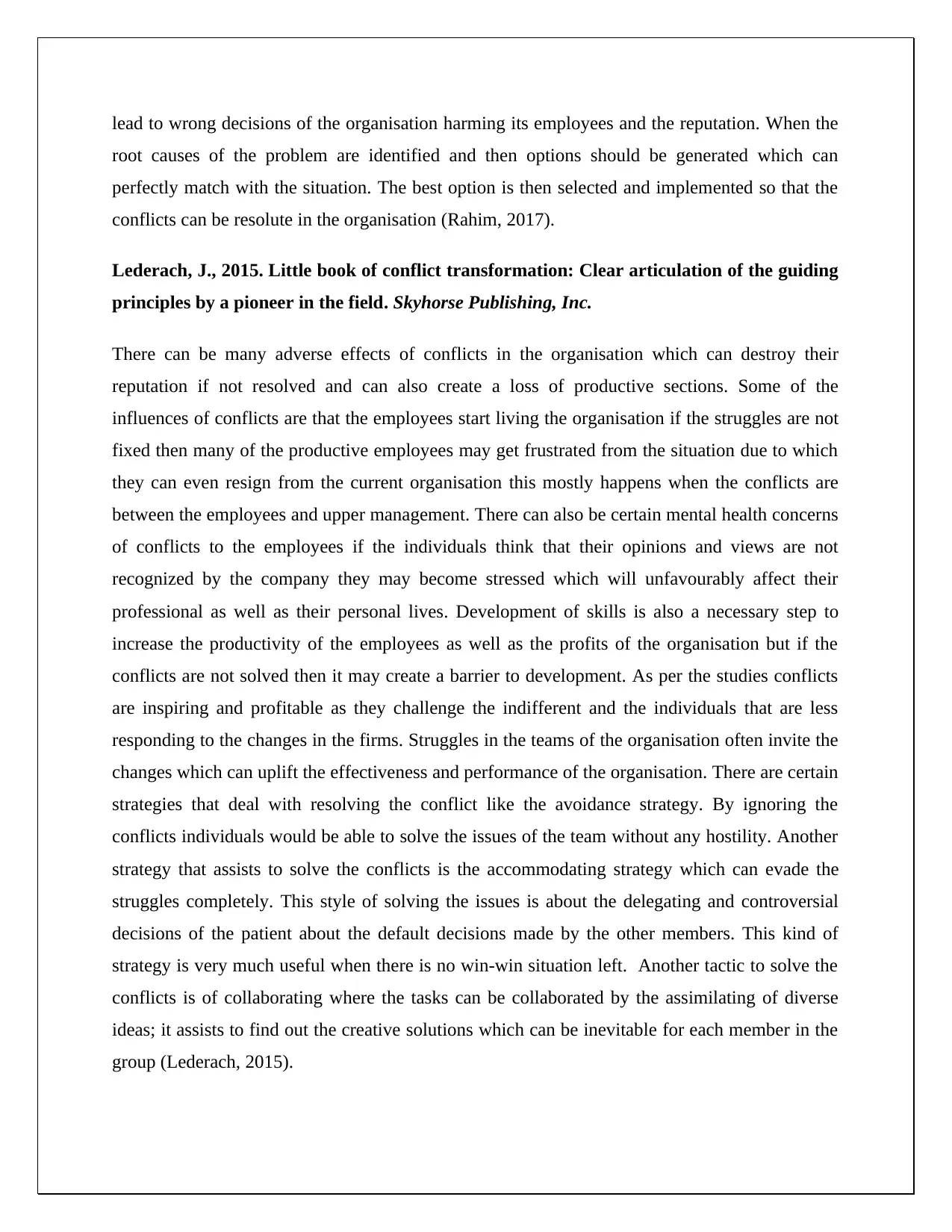
lead to wrong decisions of the organisation harming its employees and the reputation. When the
root causes of the problem are identified and then options should be generated which can
perfectly match with the situation. The best option is then selected and implemented so that the
conflicts can be resolute in the organisation (Rahim, 2017).
Lederach, J., 2015. Little book of conflict transformation: Clear articulation of the guiding
principles by a pioneer in the field. Skyhorse Publishing, Inc.
There can be many adverse effects of conflicts in the organisation which can destroy their
reputation if not resolved and can also create a loss of productive sections. Some of the
influences of conflicts are that the employees start living the organisation if the struggles are not
fixed then many of the productive employees may get frustrated from the situation due to which
they can even resign from the current organisation this mostly happens when the conflicts are
between the employees and upper management. There can also be certain mental health concerns
of conflicts to the employees if the individuals think that their opinions and views are not
recognized by the company they may become stressed which will unfavourably affect their
professional as well as their personal lives. Development of skills is also a necessary step to
increase the productivity of the employees as well as the profits of the organisation but if the
conflicts are not solved then it may create a barrier to development. As per the studies conflicts
are inspiring and profitable as they challenge the indifferent and the individuals that are less
responding to the changes in the firms. Struggles in the teams of the organisation often invite the
changes which can uplift the effectiveness and performance of the organisation. There are certain
strategies that deal with resolving the conflict like the avoidance strategy. By ignoring the
conflicts individuals would be able to solve the issues of the team without any hostility. Another
strategy that assists to solve the conflicts is the accommodating strategy which can evade the
struggles completely. This style of solving the issues is about the delegating and controversial
decisions of the patient about the default decisions made by the other members. This kind of
strategy is very much useful when there is no win-win situation left. Another tactic to solve the
conflicts is of collaborating where the tasks can be collaborated by the assimilating of diverse
ideas; it assists to find out the creative solutions which can be inevitable for each member in the
group (Lederach, 2015).
root causes of the problem are identified and then options should be generated which can
perfectly match with the situation. The best option is then selected and implemented so that the
conflicts can be resolute in the organisation (Rahim, 2017).
Lederach, J., 2015. Little book of conflict transformation: Clear articulation of the guiding
principles by a pioneer in the field. Skyhorse Publishing, Inc.
There can be many adverse effects of conflicts in the organisation which can destroy their
reputation if not resolved and can also create a loss of productive sections. Some of the
influences of conflicts are that the employees start living the organisation if the struggles are not
fixed then many of the productive employees may get frustrated from the situation due to which
they can even resign from the current organisation this mostly happens when the conflicts are
between the employees and upper management. There can also be certain mental health concerns
of conflicts to the employees if the individuals think that their opinions and views are not
recognized by the company they may become stressed which will unfavourably affect their
professional as well as their personal lives. Development of skills is also a necessary step to
increase the productivity of the employees as well as the profits of the organisation but if the
conflicts are not solved then it may create a barrier to development. As per the studies conflicts
are inspiring and profitable as they challenge the indifferent and the individuals that are less
responding to the changes in the firms. Struggles in the teams of the organisation often invite the
changes which can uplift the effectiveness and performance of the organisation. There are certain
strategies that deal with resolving the conflict like the avoidance strategy. By ignoring the
conflicts individuals would be able to solve the issues of the team without any hostility. Another
strategy that assists to solve the conflicts is the accommodating strategy which can evade the
struggles completely. This style of solving the issues is about the delegating and controversial
decisions of the patient about the default decisions made by the other members. This kind of
strategy is very much useful when there is no win-win situation left. Another tactic to solve the
conflicts is of collaborating where the tasks can be collaborated by the assimilating of diverse
ideas; it assists to find out the creative solutions which can be inevitable for each member in the
group (Lederach, 2015).
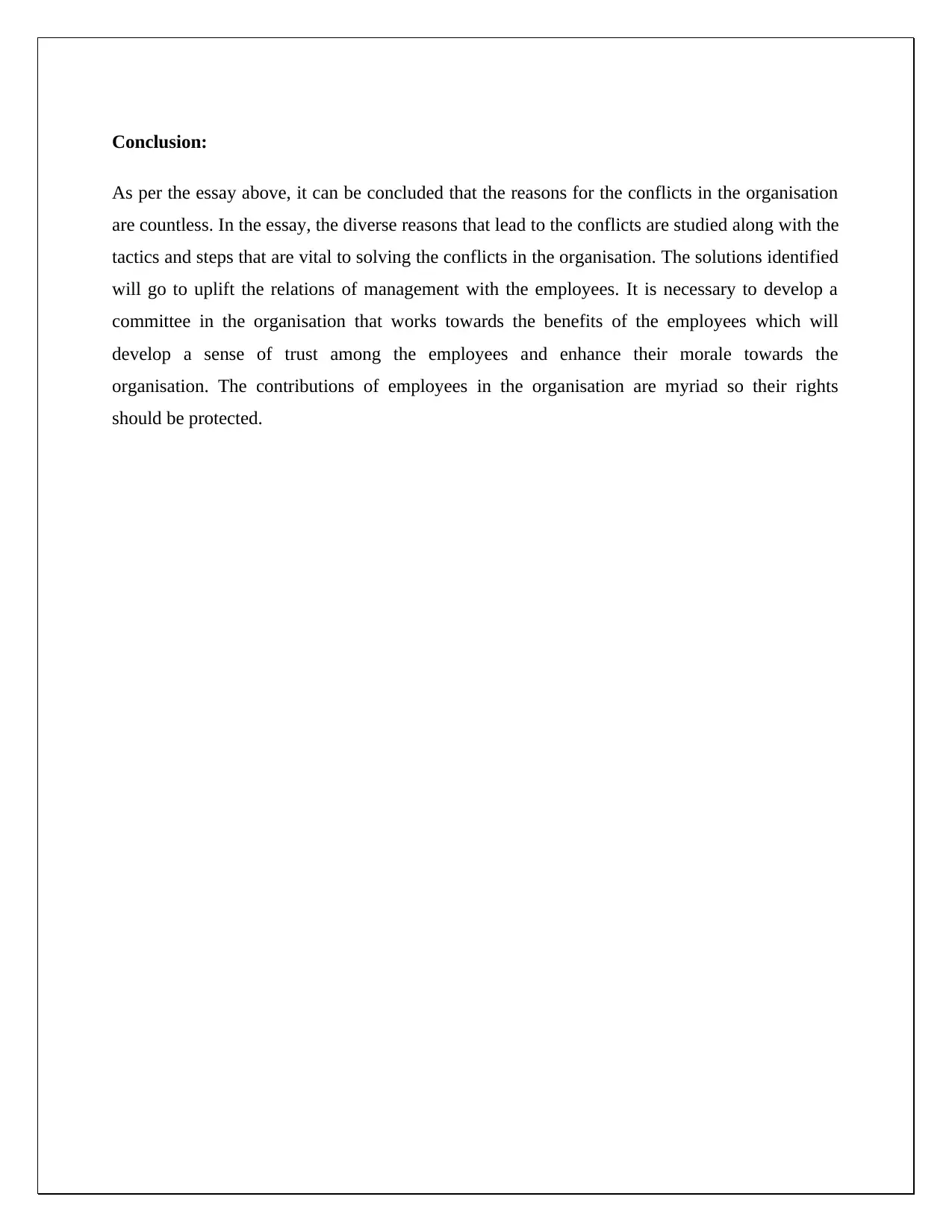
Conclusion:
As per the essay above, it can be concluded that the reasons for the conflicts in the organisation
are countless. In the essay, the diverse reasons that lead to the conflicts are studied along with the
tactics and steps that are vital to solving the conflicts in the organisation. The solutions identified
will go to uplift the relations of management with the employees. It is necessary to develop a
committee in the organisation that works towards the benefits of the employees which will
develop a sense of trust among the employees and enhance their morale towards the
organisation. The contributions of employees in the organisation are myriad so their rights
should be protected.
As per the essay above, it can be concluded that the reasons for the conflicts in the organisation
are countless. In the essay, the diverse reasons that lead to the conflicts are studied along with the
tactics and steps that are vital to solving the conflicts in the organisation. The solutions identified
will go to uplift the relations of management with the employees. It is necessary to develop a
committee in the organisation that works towards the benefits of the employees which will
develop a sense of trust among the employees and enhance their morale towards the
organisation. The contributions of employees in the organisation are myriad so their rights
should be protected.
⊘ This is a preview!⊘
Do you want full access?
Subscribe today to unlock all pages.

Trusted by 1+ million students worldwide
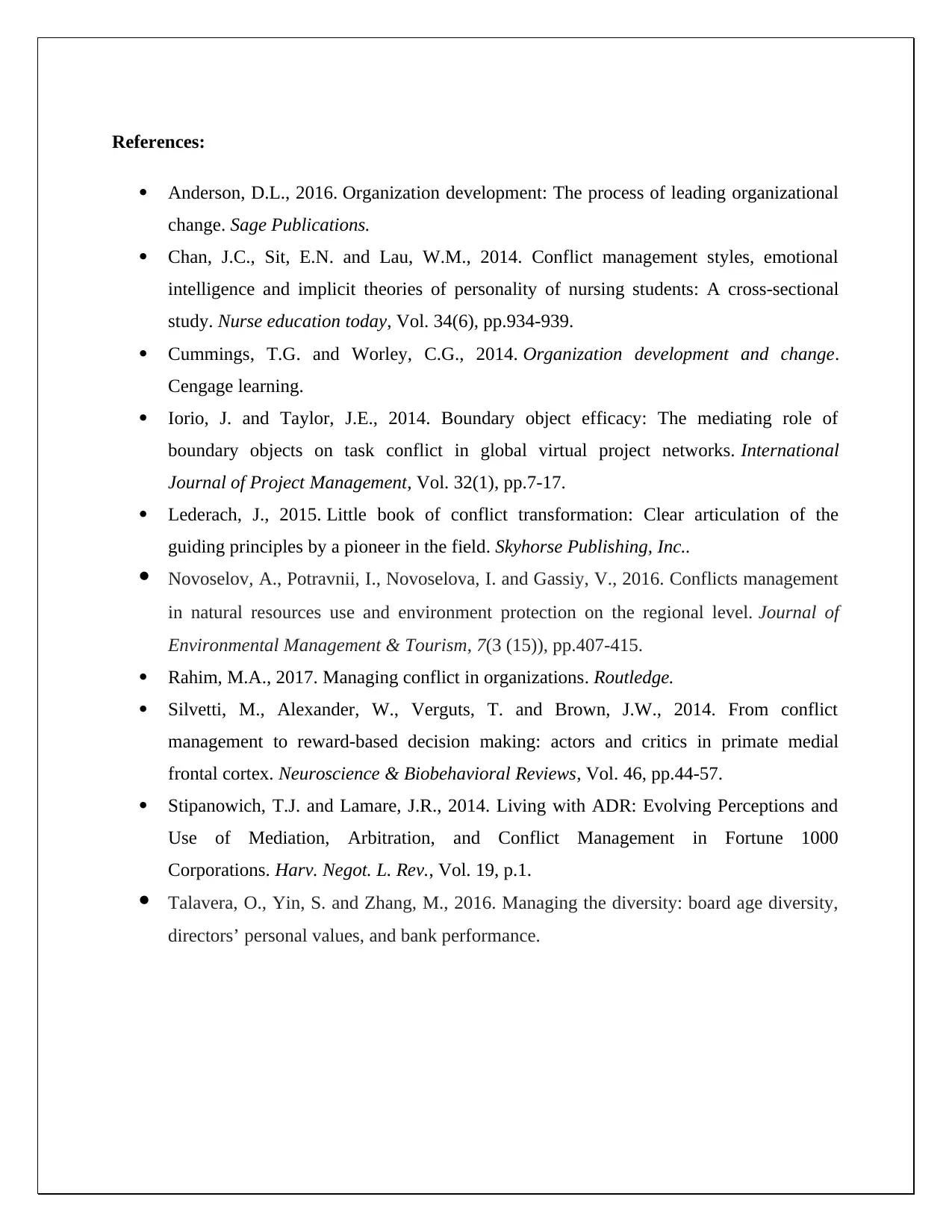
References:
Anderson, D.L., 2016. Organization development: The process of leading organizational
change. Sage Publications.
Chan, J.C., Sit, E.N. and Lau, W.M., 2014. Conflict management styles, emotional
intelligence and implicit theories of personality of nursing students: A cross-sectional
study. Nurse education today, Vol. 34(6), pp.934-939.
Cummings, T.G. and Worley, C.G., 2014. Organization development and change.
Cengage learning.
Iorio, J. and Taylor, J.E., 2014. Boundary object efficacy: The mediating role of
boundary objects on task conflict in global virtual project networks. International
Journal of Project Management, Vol. 32(1), pp.7-17.
Lederach, J., 2015. Little book of conflict transformation: Clear articulation of the
guiding principles by a pioneer in the field. Skyhorse Publishing, Inc..
Novoselov, A., Potravnii, I., Novoselova, I. and Gassiy, V., 2016. Conflicts management
in natural resources use and environment protection on the regional level. Journal of
Environmental Management & Tourism, 7(3 (15)), pp.407-415.
Rahim, M.A., 2017. Managing conflict in organizations. Routledge.
Silvetti, M., Alexander, W., Verguts, T. and Brown, J.W., 2014. From conflict
management to reward-based decision making: actors and critics in primate medial
frontal cortex. Neuroscience & Biobehavioral Reviews, Vol. 46, pp.44-57.
Stipanowich, T.J. and Lamare, J.R., 2014. Living with ADR: Evolving Perceptions and
Use of Mediation, Arbitration, and Conflict Management in Fortune 1000
Corporations. Harv. Negot. L. Rev., Vol. 19, p.1.
Talavera, O., Yin, S. and Zhang, M., 2016. Managing the diversity: board age diversity,
directors’ personal values, and bank performance.
Anderson, D.L., 2016. Organization development: The process of leading organizational
change. Sage Publications.
Chan, J.C., Sit, E.N. and Lau, W.M., 2014. Conflict management styles, emotional
intelligence and implicit theories of personality of nursing students: A cross-sectional
study. Nurse education today, Vol. 34(6), pp.934-939.
Cummings, T.G. and Worley, C.G., 2014. Organization development and change.
Cengage learning.
Iorio, J. and Taylor, J.E., 2014. Boundary object efficacy: The mediating role of
boundary objects on task conflict in global virtual project networks. International
Journal of Project Management, Vol. 32(1), pp.7-17.
Lederach, J., 2015. Little book of conflict transformation: Clear articulation of the
guiding principles by a pioneer in the field. Skyhorse Publishing, Inc..
Novoselov, A., Potravnii, I., Novoselova, I. and Gassiy, V., 2016. Conflicts management
in natural resources use and environment protection on the regional level. Journal of
Environmental Management & Tourism, 7(3 (15)), pp.407-415.
Rahim, M.A., 2017. Managing conflict in organizations. Routledge.
Silvetti, M., Alexander, W., Verguts, T. and Brown, J.W., 2014. From conflict
management to reward-based decision making: actors and critics in primate medial
frontal cortex. Neuroscience & Biobehavioral Reviews, Vol. 46, pp.44-57.
Stipanowich, T.J. and Lamare, J.R., 2014. Living with ADR: Evolving Perceptions and
Use of Mediation, Arbitration, and Conflict Management in Fortune 1000
Corporations. Harv. Negot. L. Rev., Vol. 19, p.1.
Talavera, O., Yin, S. and Zhang, M., 2016. Managing the diversity: board age diversity,
directors’ personal values, and bank performance.
1 out of 10
Related Documents
Your All-in-One AI-Powered Toolkit for Academic Success.
+13062052269
info@desklib.com
Available 24*7 on WhatsApp / Email
![[object Object]](/_next/static/media/star-bottom.7253800d.svg)
Unlock your academic potential
Copyright © 2020–2025 A2Z Services. All Rights Reserved. Developed and managed by ZUCOL.




